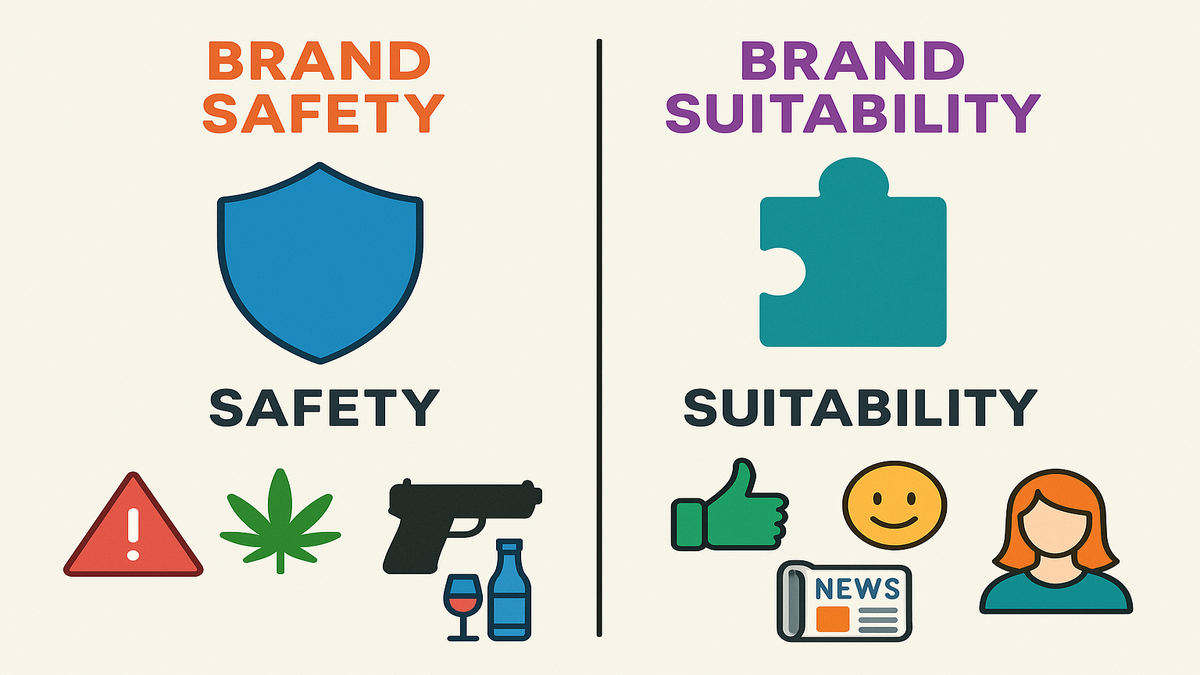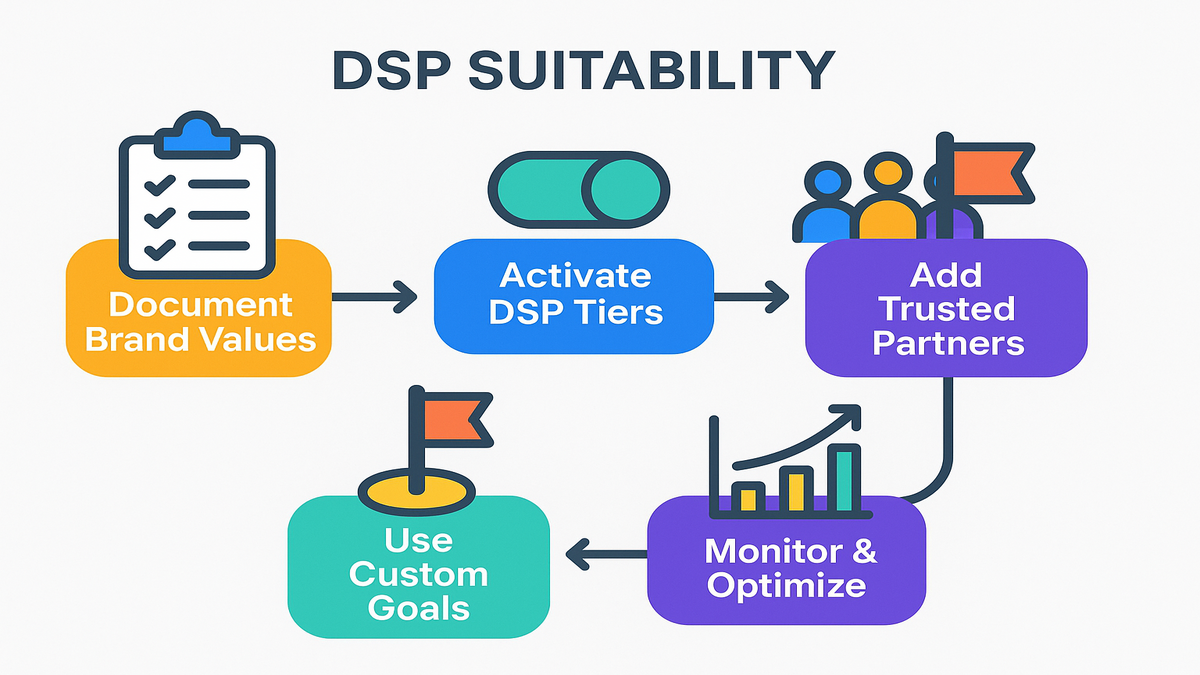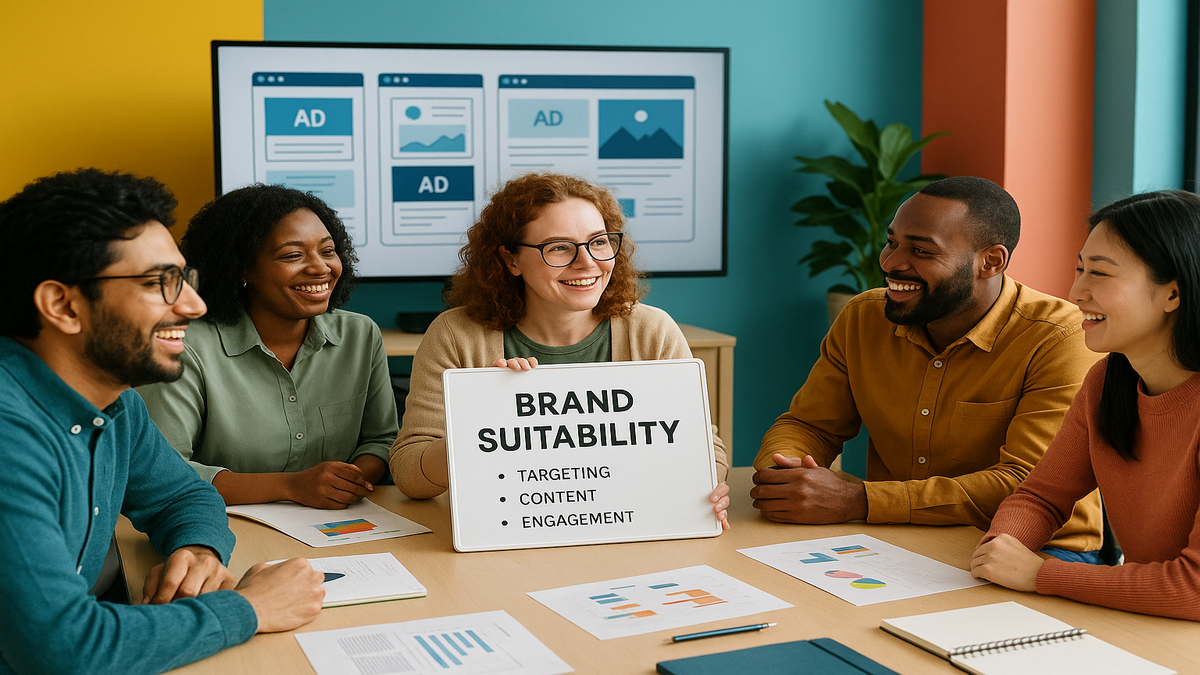
How to Master DSP Brand Safety and Suitability Settings

Think your brand is in the clear just because your ads skip those wild alien conspiracy clips? Hold up. The big risk isn’t just steamy or sketchy content—it’s shoving your brand somewhere your ad honestly doesn’t fit.
Picture this: You blow your budget on a major ad storm. Feels good, right? Until you spot your family-friendly pet food ad cozied up next to a hunting show. Yikes. You might tick the “brand safe” box, but that doesn’t mean you’re in the right spot. Here’s the truth nobody tells you: “Safe” placements keep you out of trouble, but “suitable” placements actually boost your brand.
That right there—that’s what brand suitability is. It’s the difference between being ignored and actually connecting. When your ad belongs where it’s shown, you build trust. Get it wrong, you look out of place and confuse people about what you stand for.
New tools are changing the game: Amazon DSP and Adobe Advertising DSP now have test features that give you tight control. Think: laser focus about where your ads land, based on real emotion and fit. Next up, we’ll break down these new tools, who’s winning with them, and why caring about this stuff could be your brand’s biggest move this year. Want more tips or help? Check out our DSP Services so you don’t get left behind.
Key Takeaways
- DSP brand suitability means matching the vibe, not just protecting your name
- Amazon DSP & Adobe Advertising DSP let you fine-tune placements in open beta
- Pre-bid filters make sure your ad never lands in weird spots
- DoubleVerify, IAS, and others help protect your brand to the max
- Custom goals and segment IDs let you shape settings for your own brand
- All this is in open beta—test, tweak, and get ahead now

Why Brand Suitability is the New Brand Safety
Safety vs. Suitability
Let’s be honest: "Brand safety" just meant dodging bad stuff—NSFW rants, hate speech, pirated stuff. Lowest bar. But safe vs. suitable? It’s like taking any open seat vs. grabbing front row at a sold-out show. Suitability means your brand shines, because the content matches your message—not just keeping you away from drama.
Don’t just take my word. Claire Atwell, a digital strategist, puts it like this: “Brand suitability is how you make sure your ad money actually builds your brand, not just keeps you out of hot water.” You can dodge PR nightmares and still get nowhere. Or you can use suitability to make fans and get real results.
Beyond Blocked Lists
Old school brand safety? That’s just blocking nasty keywords and bad categories. But say you sell vegan snacks. You probably don’t want your ad on heavy metal tracks, even if they’re squeaky clean. Here, suitability is the trick—it’s about finding spots that match your brand’s style. If you’re a B2B SaaS, you won’t want prank videos. Health brand? You’ll dodge true crime podcasts. It’s not only about “safe”—it’s about content that clicks with your people.
Inside the Open Beta: Amazon & Adobe DSP Brand Suitability Controls
What’s New?
This isn’t just a new box to check. Amazon and Adobe are testing new ways to put you in charge of where your ads go.
Amazon’s Suitability Tiers
Amazon is rolling out custom suitability levels in their API. You can go from chill all the way up to "nuclear" (so strict, even shady jokes get blocked). Here’s how it plays out:
- Use
brandSafetyTierInheritedSettingDetailsto set rules for your whole advertiser profile—it’s peace of mind, minus all the little tweaks. - Or get detailed and use
brandSafetyTierTarget, setting different rules for different ad groups. Handy if you sell lots of stuff to very different crowds. - Right now, this is for Twitch ads (Display and Video). That’s a big deal if you want Gen Z and gamers. Twitch has over 31 million users a day. Loads of eyes—some risk, too.
Adobe DSP & DoubleVerify
Adobe and DoubleVerify have teamed up for "Authentic Brand Safety". Here’s what you get:
- Pre-bid checks mean your ad never hits a bad spot—even before the auction happens.
- Use DoubleVerify segment IDs to lock your campaigns into your own rules. You can get really picky: topics, mood, even what kind of content your creative runs on.
- Plus, set custom goals and weights. It’s not just about protecting your brand—you can also push for better results, so you don’t have to pick between image and performance.
Contextual Filtering Partners
Want even more control? Stack on partners like:
- Comscore – for deep dives into who’s watching
- Integral Ad Science (IAS) – for matching by mood, topic, and blocking fake traffic
- Peer39 – to block weird viral challenges or trending memes. Tired of your CPG ad on a "24-Hour Silence Challenge"? Peer39 fixes that.
Real world: luxury watch brands often block pranks, meme vids, and silly humor. Sure, those get lots of views—but not from the right crowd.
Real-World Impact of Suitability
Pre-Bid Protection
Marketers love pre-bid filters for one thing: they save money. You weed out junk before you bid, so you don’t pay for lousy ad slots. Every buck goes toward people you actually want to reach. That means better ROI and less worry about your brand ending up in a bad place.
You’ll also breathe easier looking at your campaign results. No more, “How did our ad get there?!” headaches.
Nick Tran, ex-TikTok marketer, says it straight: “Winners don’t just avoid trouble—they look smart by always landing in the right context. Brand suitability does that.”
Amazon & Twitch Example
Want an example? Say you sell drinks to Gen Z—your crowd lives on Twitch. With Amazon’s new tiers, you block out any nasty, edgy, or controversial streams. Your ad only shows in clean and fitting shows. It fits your fun, friendly vibe and you reach exactly who you want.
That can make or break your campaign. You go from a so-so ad to maybe going viral in all the right places.
Feedback Loops in Beta
Here’s the fun of beta: you control the future. Not working right? Give feedback. See a way to make it better? Suggest it. Beta users help build what’s next.
It’s like hanging backstage at a rock show. You see what’s coming and get to shape the final set. Your ideas can change the way these tools work.

Setting Up DSP Suitability
Start With Brand Values
Get clear before you touch your DSP tools. What will you never allow? Is joking about politics too risky? Would being next to tough news hurt your brand?
Make a "nope" list: these topics, genres, language, images are off-limits. Don’t only think “bad”—think of what doesn’t fit. For example:
- B2B SaaS: skip meme humor, trash talk, or too much youth stuff.
- Family brands: steer away from grown-up topics, even if "allowed."
- Health brands: block wild news, intense gaming, or anything not your style.
Who’s your ideal fan—fun and silly, or super serious?
Use Trusted Partners
Pick partners who know the pitfalls:
- DoubleVerify for blocking or allowing the right segments
- IAS for matching mood and context
- Peer39 for getting super picky, down to fresh memes or weird trends
Building your team is like picking superheroes—you want different skills, so nothing gets through the cracks.
Set, Test, Optimize
- On Amazon? Set tiers or upload your own segment IDs in the dashboard or API.
- Using Adobe? Try custom goals with “ADSP_”, then tweak the scoring to mix safety and performance.
- Always update your filters and audit your whitelist/blacklist. Don’t slack. One bad site ruins a great run.
- Keep tuning based on live feedback. Suitability is a moving target—keep up with your audience’s changing tastes.
Monitor and Iterate
The trick here is to stay flexible. Read your reports. Did you pay more or less as you got stricter? Did people care more? Catch the right folks? Or did you block too much? Beta is where you mess up, fix things, and get sharper.
Report every off-kilter placement. Fewer bad mentions and better KPIs means you’re on the right road.
Suitability as a Strategy
Precision, Not Just Protection
Suitability isn’t just a switch to flip. It’s how smart brands save money and look great. IAS’s 2023 survey found 76% of marketers say spots that fit the context do better than just safe spots—for both clicks and buys.
So what does that mean? Spend less on wasted ads, reach the right crowd, build long-term brand power. Suitability isn’t some fancy extra—you’ll soon be way ahead of folks just blocking adult content.
Customization Results
Check these:
- Amazon DSP brands using suitability tiers had 16% fewer negative mentions vs. just safety alone. (Amazon data, Q1 2024)
- Adobe DSP beta users with DoubleVerify custom segments saw click rates jump 10–20% by matching placements better. (Adobe x DV pilot feedback)
- A top consumer tech brand dropped their cost-per-engaged-user by 22% after blocking bad-fit stuff in beta.
When you push suitability, you’re not just dodging trouble—you’re creating real fans and better ROI.
The Beta Learning Curve
Every test, tip, and goof you make in beta teaches you something. Once this goes public, your team will be sharp—and you’ve helped shape the final product. You’re investing in the future of ad placement, not just your next campaign.
TL;DR: Suitability Unlocked
- Brand suitability tools aren’t extra—they’re now a must for careful brands
- Early beta = secret edge (test now, fix now, win later)
- Pre-bid control, trusted partners, custom IDs, and goals = all-around brand boost
- Results = lower ad waste, bigger brand buzz, fewer PR nightmares
- Start early, own your results
FAQ: DSP Brand Suitability
What’s the difference between brand safety and brand suitability?
Brand safety = keep ads off nasty stuff. Brand suitability = only show up where it feels right for you. It’s a smarter filter.How do Amazon DSP and Adobe DSP support suitability controls?
Amazon gives you suitability tiers and picky settings (API access for now, mainly for Twitch). Adobe DSP brings in DoubleVerify and other partners for lots of custom options.Why is this only in open beta?
Features are still in the works—ad pros are testing, giving feedback, and smoothing out bugs. Think of it as an early test run for ad nerds.What third-party tools should I activate?
DoubleVerify for custom segments, plus Comscore and IAS for extra context. Peer39 for meme-level detail. The tighter, the better.Can this lower my CPM or improve results?
You bet. Block wasted placements, see better engagement, maybe even more conversions—if your target audience actually sees your ad in the right spots.How do I know if my settings work?
Watch your reports. Compare campaigns. Look at CPM, click rates, brand lift. If you see fewer bad placements and more clicks, you’re winning.
Step-By-Step Guide for DSP Suitability
- Write down your non-negotiable brand rules (mood, themes, trigger topics)
- Fire up DSP suitability tiers or set your own segment IDs in your platform or API
- Team up with DoubleVerify, IAS, Peer39 for top-tier control
- Use custom goals and weights to balance fit and results—they can work together
- Keep checking reports and fine-tune constantly—especially while in beta
Ad rules are changing: soon, every programmatic ad buy needs suitability—not just safety—to truly boost your brand. Try early, learn fast, and make your brand stand out. Fitting in is the new flex.
Ready to try this out? Jump into our Features and see how these tools can upgrade your brand’s ad game before your rivals even see what’s happening.

